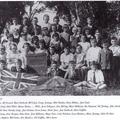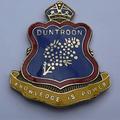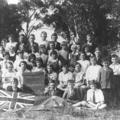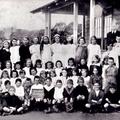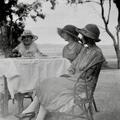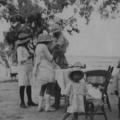< Early Canberra Government Schools
Duntroon School [1915 - 1970]
"The establishment of the Royal Military College in 1911 brought families of staff to Duntroon, and their need for schooling. Initially this was done at the College by Miss Ada Curley, elder sister of Sylvia Curley (1898–1999) later to become famous in Canberra as a hospital matron and nursing administrator. This informal arrangement with Ada Curley lasted until 1914.
By 19 September 1913 there were 80 children at Duntroon and surrounding area who required schooling. On 19 August 1913 H M Rolland (the resident government Architect in Canberra) wrote to the Works Director: "In connection with the provision of Schools in the Federal Territory, the Administrator has asked me to inform you that it is proposed to erect schools in Rottenberry's paddock, near Groundsmen's Cottages, Duntroon, and a canvas structure at the Cotter River".
There was not to be a new building for Duntroon. Already, in 1912 General Bridges, Commandant of the College, despairing of a school being built, had suggested that the hospital dispensary of the Home Affairs Employees Hospital at Duntroon be converted into a school. This was done by April 1914, at a cost of ₤25. Over the next two decades Duntroon school occupied a number of different sites at RMC. Children from neighbouring farms boosted the attendance which was between 30 and 50 in those days. The first site of the school was on an area where the present day Australian Defence Force Academy (ADFA) is built.
In September 1914, Mr David Jones was appointed to Duntroon School as first and long-serving teacher. (He was previously teacher at the Canberra Public School, renamed 'Ainslie', alongside St Johns Church, which closed in 1914). Teacher Jones suffered a serious accident shortly after taking up his position at Duntroon:
"Sir, I have the honour to inform you that on being liberated from quarantine on Wednesday 28th ultimo [in November 1914] I rode over to the doctor's house that night to secure a certificate for my absence in quarantine. While mounting my horse for the return journey it became frightened and bolted with the result that I was thrown heavily and dragged some distance.
On recovering my senses I managed to reach the nearest house and was taken from there to the doctors and by him to the hospital. Though I am back home again it is unlikely that I will be able to teach this week as owing to bruises I am not able to walk without difficulty and my head is constantly aching. Besides, my left arm is in a very bad state from the vaccination and is practically useless. I shall get back to work immediately I am able, Yours etc.."
In October 1915 Jones was advised that, having successfully gained a Pass (Honours) in Miniature Rifle Shooting at the School of Instruction in Junior Cadet Training held at Goulburn, he would be permitted to supervise rifle shooting instruction for the school's junior cadets [Memo from Chief Inspector, 26 October 1915].
By 20 November 1918 the school was extended. (see the 1916 photo below)The old verandah was closed in to extend the room and a new verandah added. The extensions were not sufficient for the needs; on 5 May 1919 Mr Jones complained that there were 44 students and seating for 33. The extensions had been made during the Christmas holidays but seating had not been provided for the additional students. The children had to wait another few months before they were provided with adequate furniture.
On 16 February 1920 Major Henry Stoker (MD) reported on the size and design of the school. He noted that the school was a converted building running north and south consisting of two main rooms and two smaller ones which were used as a cloak room and wash room. He commented that the heat was overpowering in the rooms and opined that 'continued use...could only be done at the expense of the health of the staff and children'. Major Stoker recommended that the temporary buildings be replaced with a permanent brick school. 19 May 1920 the chimney smoked so badly that the fire was not lit. 14 July 1921 Mr Jones had to refuse admittance to three Leech children because the enrolment of the school was 88 and there was seating for 74. Fortunately the Leech family moved to Molonglo where they could attend the school there. In January 1922 children returned to school after the holidays to find that the lavatory pans hadn't. The school remained without sanitary arrangements for a week that necessitated Mr Jones and the senior boys carrying out some cleaning work.
By May 1923 the need for a residence for Mr and Mrs Jones and family became urgent. The couple had lived with an unmarried relative who was about to marry. When Gungahleen school closed on 28 May 1923 it was refurbished as a residence for Jones. Mr Jones offered to give a lift in his car to Duntroon school to the six children of Gungahleen then without a school. This act of kindness added an additional five miles to his weekly trip up from 45 to 50 and Mr Jones put in a request for an additional amount in his allowance. In April 1930 the Gungahleen children driving to school with their teacher were Mack, Jean and Thelma Southwell, Sheila Jones, and Peter Shumack.
Cleaning of the school was always a problem. It was carried out by students who were paid such a small amount that in the end they refused to do the work. The problem was solved when the department paid better money and a permanent cleaner was employed. Mrs W Clark began work in March 1924 and was paid ₤36 pounds per annum. She lived in nearby 'Toorak'.
At the time of an inspection of the Territory's schools in 1926 the average attendance at Duntroon was 72 pupils. Jones reported "a noticeable increase in the demand upon his services arising from the establishment of a constructional settlement by the [Federal Capital] Commission on the westerly slopes of Mount Russell.[now known as Mount Pleasant?]. The Federal Capital Commission responded to this increased demand by opening the Russell Hill school in 1927
When the Royal Military College moved to Victoria Barracks in Sydney in 1931, the consequent drop in attendance at Duntroon School was compensated by the closure of Majura Public School further up the Majura valley. For the next few years Duntroon School now used the vacated College classrooms at Duntroon. In 1936, with the College soon to return to Duntroon, a permanent school was at last built, sited just across the Woolshed Creek from Duntroon No 1 Oval. The Canberra Times reported as follows:
"Duntroon – New School to be Built – Will serve home garden sites. In view of the return of the Royal Military College to Duntroon early next year steps have been taken to provide educational facilities for the children of Duntroon and the Pialligo area. Tenders have been invited for the erection of a school, schoolmaster's residence, garage and shelter shed, together with the necessary conveniences. The site chosen for the new building is on the southern side of Woolshed Creek near the Duntroon - Queanbeyan road. Tenders will close April 21.[Canberra Times 15 April 1936]. (see recent photos of 'Duntroon Primary School' below).
It remained closely connected with the College however, making occasional use of the gymnasium, sporting fields, swimming pool and cinema hall, while the school's musical education benefited from its contact with the RMC Band. The RAAF base at Fairbairn also lent its facilities to support school activities. No doubt the active Duntroon School Parents & Citizens Association was a big help. Its preserved records show a wide range of army and air force ranks held by its office bearers, including that of major general.
On seeing the Duntroon Public School badge for the first time (see photo below), one can be forgiven for thinking that it is a military badge. Made of enamelled brass, it has a gilt crown on top, the word Duntroon is prominently displayed, its colours are red and blue, and at the bottom there is a scroll bearing the words 'Knowledge is Power' – the English translation of the RMC Latin motto. Although not a military badge, this badge is indeed closely connected to the RMC
At its peak around 1960, the School had six teachers and over 200 pupils. Over the next decade attendance declined considerably, thanks partly to more service families living in Canberra suburbs rather than at Duntroon. In 1970 the remaining 135 pupils were transferred, mostly to Campbell Primary School, and Duntroon Public School closed after 34 years at that site.
The school buildings beside the Woolshed Creek still remain however. From 1972 until 1977, the Association for Modern Education (AME) School was there and since 1983 the buildings have been used by the Richmond Fellowship to provide youth, family and mental health services to the ACT communities".
Pupil's memories - Duntroon School
[From 'Past images, present voices', compiled by Val Emerton].
Coral Charlton
"When I was seven I went to school at Duntroon. The school master was Mr Jones, and you know he took all the pupils – from five to fifteen. He was only a young man and he was marvellous really the way he taught all those different ages. The Oldfields, the Southwells, the Ginns, the Shumacks and the Edlingtons were amongst my schoolmates.
We used to walk all the way to school on our own – we weren't driven in a sulky and I couldn't ride a horse – never took to them. As we walked along we would make three tracks and would run along with one pretending they were the horse and the others were the two wheels of the sulky.
We'd start out to school, first we would meet Jack Mayo, and then we would walk down a bit further and pick up Ruth Mayo and then we'd all walk across the 'big plain' and on to Duntroon. On the way across the big plain we would often play in the air raid shelters that had been dug for WW1. There were always lots of kids going to and fro across the plain and we had a lovely time really" (p. 9)
Eleanor Stirling
"In 1932, when the Royal Military College had moved out of Duntroon and gone to Sydney, we were offered a house out there. We were there for five years – I was nine when we left. Duntroon had become a sort of suburb and it was just magic there......
My brothers and I went to Duntroon School, it was both an infants and a primary school. Our playground was where the parade ground is now and the schoolrooms were grouped around it. I think the headmaster lived in Duntroon House. His wife used to teach sewing and a little tribe of us used to go there for sewing lessons. Maude Rien was one of the teachers – she taught my brothers" (p. 149)
Harry Trevillian
"I first went to school at the Narrabundah School, which was near the Fire Station at Manuka. I remember the big fireplace in the old schoolhouse. Mr Kemp was the teacher [1916-1923] and he used to ride a motor bike and sidecar in from Queanbeyan where he lived. He was a great gardener and used to have us kids growing a vegetable patch. On several occasions when I was going to Narrabundah School there was heavy rain and we used to have to get Billy Webb's horse and sulky to go through the flooded creek even thought the school was only a short walk away.
I thought Narrabundah was a pretty good school, but my father reckoned there was a better teacher over at Duntroon, so I had to go there until Telopea Park School opened in 1923. I went to Duntroon School with about eight of the kiddies who lived around the Power House – we used to walk across the weir. I first started to smoke down at the weir – lit up willow roots with no paper. It put me off smoking until I was about twenty-two or so.
I think we were about half boys, half girls who walked over to Duntroon School. I know the Gray boys used to be with us and when we were walking home we used to pinch quinces from the Edlington's farm" (p. 23-4)
Memoir - Marie Stoyles
"In 1915 I started school although I was already six years old. Duntroon school opened that year. Miss Casey was my first teacher. She came to school by horse and sulky and lived with her parents over behind Mount Ainslie. Her Dead was an ex-convict, a ticket-of-leave man. In 4th, 5th and 6th grades my teacher was Mr David Jones. They were both very good teachers and gave me a good grounding......................In 1919 I remember when Ross and Keith Smith, the aviators, landed where the golf course at Duntroon now is. They'd flow from England to Australia after the war. The whole school went out and we all stood there waiting. They flew from Sydney to Queanbeyan following the railway line and then they flew across to Duntroon from there. We could see th e little black spec coming and when it landed, they pegged it down".
[Settlers Stories [1913-1975], Canberra Stories Group, 2000. p.37]
Presentation to Miss Casey at Duntroon.
On Wednesday last a very interesting event took place at Duntroon. Miss L. Casey who was assistant teacher at the Duntroon Public School was made a presentation of a gold wristlet watch by past and present pupils. Miss Casey was at Christmas last, transferred to Leichardt and had no opportunity to say goodbye to the children, and arrangements were made that during the Easter vacation for a social to be held, and it was suggested that a fitting present should be given to Miss Casey for her splendid work at Duntroon. At 3.30. the children were given refreshments in the open air outside the Recreation Hall. The mothers and some of the fathers attended to the catering, and as usual with these functions there was full and plenty. After the inner man was satisfied, Mr. D. S. Jones made a very telling speech regarding Miss Casey's six years' work. He said past results of examinations spoke for themselves, as the Duntroon Public School stood second to none in N.S.W. Last Xmas four bursaries were vacant at Goulburn, and Duntroon secured two of them. Mr Gilchrist spoke on behalf of the parents, then Miss Barbara Knights accompanied by Miss Pearl Oldfield made the presentation. Miss Casey was very much affected by the goodwill shown towards her. The present from her old pupils overjoyed her. Mr. F. E. Archer responded on behalf of Miss Casey, after which an adjournment was made to the hall where the children sang a round of songs. Our old friend Mr. Jas. Stewart, late of Canberra, gave several of Harry Lauder's best songs, and thus ended a week of joyful events at Duntroon. Mention must be made of Mesdames Arnesson and Archer who worked hard to make the event a success. Thanks in general is also due to all the ladies and gents present.
[Queanbeyan Age, 5 April 1921, page 2]
References
- Anne Claoue-Long, 'The Duntroon Public School, Pialligo'. Canberra Historical Journal March 2013. [can be down-loaded below] Grateful acknowledgements to the Canberra Historical Journal] Duntroon Society Newsletter 1/2013. Based on the above.
- Val Emerton, 'Past images, present voices'. Ann Gugler, Canberra Camps, settlements and early housing', Duntroon.
- Settlers Stories [1913-1975], Canberra Stories Group, 2000.
Location Map
Related Photos
Teachers
- Jones, David Samuel
09/1914 - 07/1943 - Evans, I.
Relief, 08/1922 - 09/1922 - McDonald, Mr Martin Livingstone 'Thomas'
01/1925 - 04/1925 - Downes, J.M.
08/1926 - 11/1926 - Carter, John
03/1927 - 04/1927 - Small, Stanley
01/1928 - 02/1928 - Gamble, James
Relief, 08/1928 - 08/1928 - Hill, Beryl
08/1943 - 01/1944 - Shumack, John A.
10/1943 - 02/1949 - Grant, Albert
02/1949 - 01/1953
Related Documents
Published history:
- The Duntroon Public School, Pialligo (PDF 2.7 Mb)
NSW Government schools from 1848
- Duntroon School (external link)
< Early Canberra Government Schools
If you are able to assist our work of identifying, documenting, and celebrating the early bush schools of the Canberra region, please contact us or .


